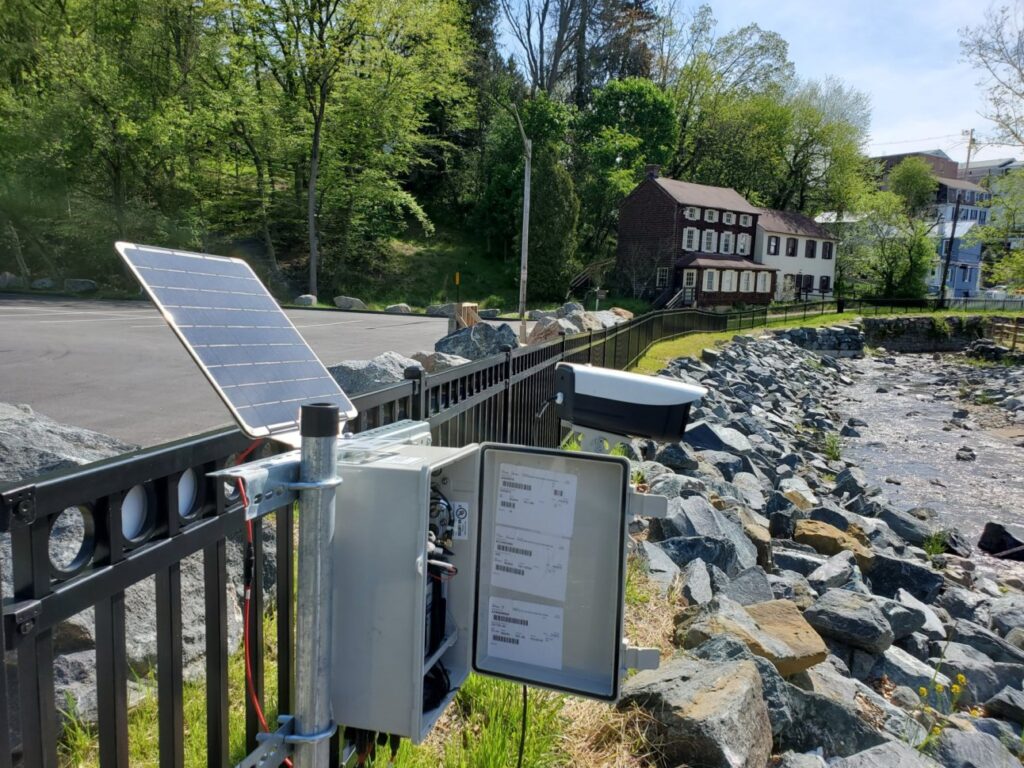Ellicott City, a town about five miles from UMBC, suffered devastating flooding in 2016 and 2018. These events left residents and officials wondering how technology could help predict future severe weather events, potentially saving lives and property.
In response to the 2016 flood, UMBC’s Nirmalya Roy, associate professor of information systems, received funding from the National Science Foundation to develop a rapid flood warning system for Ellicott City. The research was scheduled to conclude in August 2019, but Roy and his team decided to continue this work with the support of an extension from NSF.
They received multiple sensor systems from Howard County’s Stormwater Management Division to deploy in Ellicott City. Since installing the sensors in fall 2019, they have moved on to the next phase—testing their performance, to prepare for the possibility of another flood hitting the city.
Combining sensor data and social media
Roy has worked closely with Bipendra Basnyat M.S. ‘17, Ph.D. ‘23, information systems, to build and install a network of wireless sensors in Ellicott City to monitor rainfall levels. Aryya Gangopadhyay, professor of information systems and co-PI on the grant, and Neha Singh, Ph.D. ‘23, information systems, are working alongside Roy and Basnyat. They call the network Flood Bot.
They’ve also developed predictive algorithms and communication systems to provide real-time information to government officials about flood threats. And the researchers can now compare data collected by the sensors with information from social media, to confirm they are telling the same story.
“Collaborating with multiple vendors who are designing and developing commercial flood monitoring systems helped the team understand the real challenges in the field,” says Roy. “This helped drive the research in the lab to make meaningful impacts on the Ellicott City community.”
The Flood Bot sensors detect and monitor water levels of the river, as well as information about weather, rainfall, and water levels at other nearby locations in the area.

The data being collected is available to the public through a Twitter account that is automatically updated twice each day. “The transmitted data from physical sensors are then combined with tweets from in and around Ellicott City to postulate the severity of the flash flood in the area,” says Roy.
Ongoing improvements
To build the group of sensors, Basnyat customized a Raspberry Pi, a small computer that is roughly the size of a credit card. The current system is camera-based and requires time and labor to deploy and maintain. Basnyat continues to look at improvements that could make it smarter and more automated, while maintaining accuracy.
The goal is for the system to notify people as early as possible of a potential flood event, to support the safety of the community. Roy explains that the team is continuously improving and refining the alert system so that people can trust the sensors and use their findings to make informed decisions about protecting people, homes, businesses.
Basnyat shares that his physical proximity to Ellicott City plays a role in energizing him to be a part of this collaborative work. This work is contributing to the local region, since UMBC is so close to Ellicott City, he adds.
“The most exciting part of this work for me is to go back in time and see how Ellicott City streams and surrounding areas performed during different rainfall events,” he says. “Ultimately we seek to build predictive models that put our analytics at the forefront of such rainfall events, to forecast the flooding conditions and integrate them into the community’s disaster risk and reduction plan.”
Community investment and impact
After experiencing such devastating damage from back-to-back floods, the Ellicott City community is invested in this work. Local officials, like Brian Cleary, hope it will help prevent future weather events from having catastrophic impacts on the town.
Cleary is an engineering specialist for the Stormwater Management Division of the Howard County Department of Public Works. He says that working with Roy and his team has not just been beneficial in getting the gauges set up; the collaboration will also support the community for years to come.
“These gauges will help verify conditions and provide valuable data in ongoing research,” says Cleary. “It will also assist in verifying models” that will be used to protect the area from flooding moving forward.
Roy hopes to someday deploy the flood monitoring systems in other areas of Maryland and beyond. Scaling the system will require developing ways to handle “hundreds of queries from commuters and community members”—a challenge he looks forward to solving.
Banner image: Nirmalya Roy. Photo by Marlayna Demond ’11 for UMBC.

